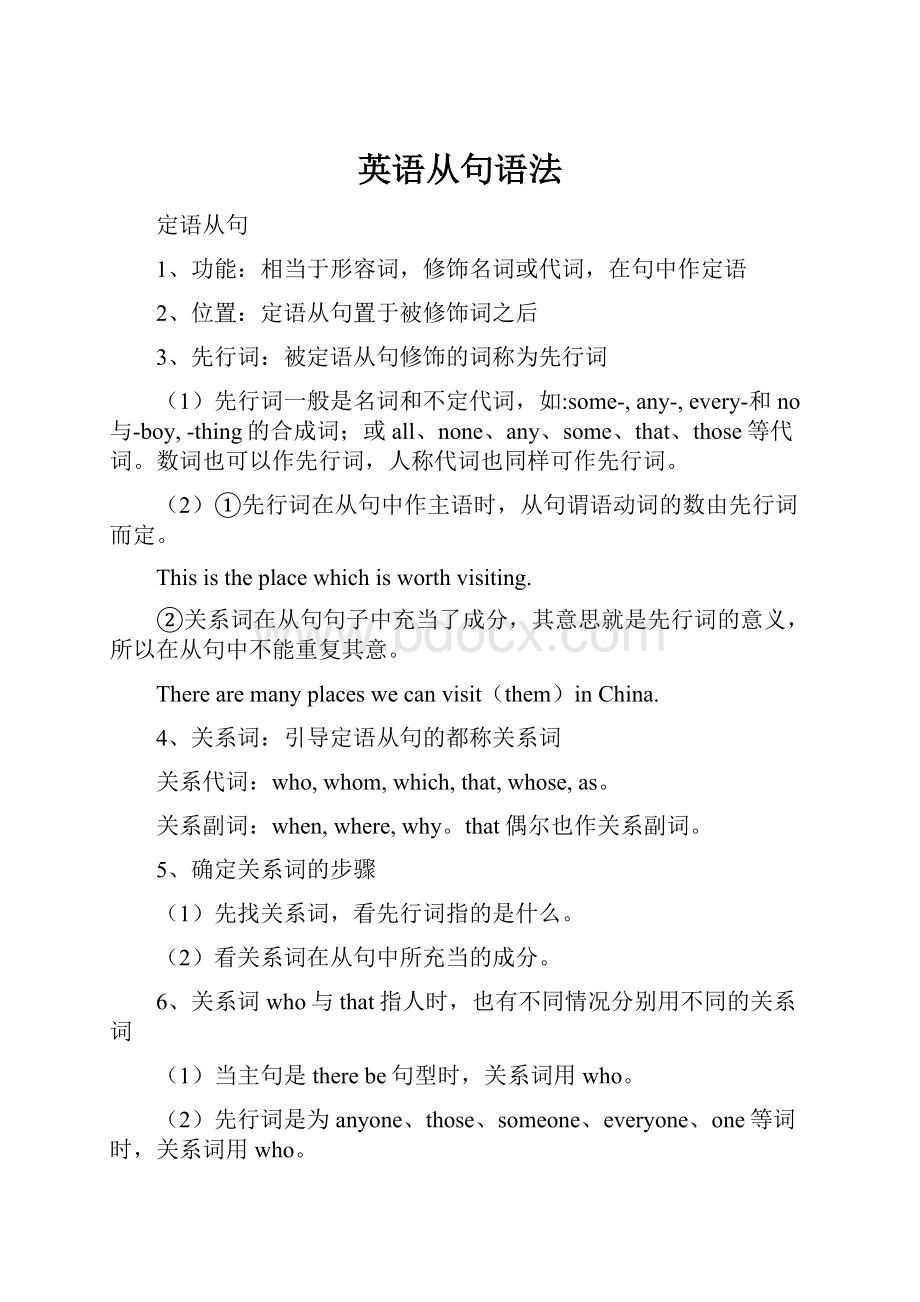英语从句语法.docx
《英语从句语法.docx》由会员分享,可在线阅读,更多相关《英语从句语法.docx(42页珍藏版)》请在冰豆网上搜索。

英语从句语法
定语从句
1、功能:
相当于形容词,修饰名词或代词,在句中作定语
2、位置:
定语从句置于被修饰词之后
3、先行词:
被定语从句修饰的词称为先行词
(1)先行词一般是名词和不定代词,如:
some-,any-,every-和no与-boy,-thing的合成词;或all、none、any、some、that、those等代词。
数词也可以作先行词,人称代词也同样可作先行词。
(2)①先行词在从句中作主语时,从句谓语动词的数由先行词而定。
Thisistheplacewhichisworthvisiting.
②关系词在从句句子中充当了成分,其意思就是先行词的意义,所以在从句中不能重复其意。
Therearemanyplaceswecanvisit(them)inChina.
4、关系词:
引导定语从句的都称关系词
关系代词:
who,whom,which,that,whose,as。
关系副词:
when,where,why。
that偶尔也作关系副词。
5、确定关系词的步骤
(1)先找关系词,看先行词指的是什么。
(2)看关系词在从句中所充当的成分。
6、关系词who与that指人时,也有不同情况分别用不同的关系词
(1)当主句是therebe句型时,关系词用who。
(2)先行词是为anyone、those、someone、everyone、one等词时,关系词用who。
(3)当主句是who作疑问词时,关系词用that。
Whoisthatgirlthatisstandingbythewindow?
(4)whom在从句中只作宾语,可被who取代。
7、whose作关系词既指人又指物,在从句中作定语。
如:
DoyouknowMr.Smithwhosestoryisverymoving?
Thereisaroom,whosewindowfacestheriver.
Thereisaroom,thewindowofwhichfacestheriver
8、关系代词as,在从句中作主语、宾语和表语。
(1)先行词被such和thesame修饰,或句型asmany(much)中,从句都用as引导。
Suchbooksasyouboughtareuseful.
Theschoolisjustthesameasitwas10yearsage.
注意:
区别①such…that…引导的结果状语从句。
Theyaresuchlovelychildrenthatwelovethemmuch.②thesame…that…引导定语从句。
Iwanttousethesametoolthatyouusedjustnow.
(2)无先行词的定语从句用as和which引导。
区别:
①意义上:
as含有“这点正如……一样”。
②位置上:
as从句可置句首,也可在另处。
Hedidn’tpasstheexam,aswehadexpected.
Thereislotsofairinloosesnow,whichcankeepthecoldout.
Asisknown,theearthisround,notflat.
9、关系副词when与where、why、that
when指时间=in/at/on/duringwhich
where指地点=in/at/from/which
why指原因=forwhich
当先行词为way、day、reason、time时,可用that作关系副词。
(非正式场合)
Idon’tlikethewaythat/inwhich/hetalks.
当time作先行词时,关系词可以省掉。
ThisisthefirsttimeIhavegivenyoualessoninFrench.
10、必须注意的问题
(1)关系词作主语时,从句中谓语的数。
(2)注意区别定语从句与强调句。
①定语从句中关系词作从句成分,复合句。
②强调it无意义,that/who不是引导词。
③去掉强调结构itis/was和that/who后如果句子意思讲得通则是强调句,讲不通则不是。
Itisthemuseumthat/whichwevisitedlastyear.(定语从句)
Itwasinthehotelthatwestayedlastnight.(强调句)
(3)定语从句与同位语从句的区别。
①定语从句引导词被称为关系词,that充当主语、宾语、表语。
有时可省略。
②同位语从句引导词被叫做连词,that不能充当任何成分,不可省。
Wordcamethattheirarmywasdefeated.(同位语)
Weexpressedtothemourwishthatwasthesameastheir.(定语)
(4)关系词在从句中省略的情况。
①关系词作宾语,前无介词时。
②关系词作表语。
(5)限制性定语从句与非限制性定语从句的翻译。
(6)关系词前有介词或复杂介词,关系词只能是which和whom。
(7)几个特殊的定语从句句型:
①Heistheonlyoneofthestudentswhohasgotverygoodmarks
inthematch.(句中one为先行词)
Heisoneofthestudentswhohavegotgoodmarksinthematch.(句中students为先行词)
②Isthisplacetheone(that)wevisitedyesterday?
Isthistheplace(that/which)wevisitedyesterday?
③Hestoodatthewindow,fromwherehecouldseewhatwashappening.
④Itmayrain,inwhichcasethematchwillbeputoff.
11、先行词只能用that的几种情况:
1.先行词为all,little,much,everything,nothing,something,anything等不定代词时,关系代词用that
2.若主句中有疑问代词who或者which,为了避免重复,关系代词不要再用who,which,而用that。
3.先行词被序数词或最高级修饰先行词前有序数词(thefirst),形容词最高级(thebest),thelast,thevery,theonly等时
4.先行词被all,little,much,every,no,等修饰时
5.先行词既有人又有物
6.先行词在主句中作表语或关系词在从句中作表语时。
7.当主句中含有疑问词which时。
Whicharethebooksthatyouboughtforme?
12、that和which的区别
1.当关系代词前有介词时,只用which.
2.先行词为that,those时,只用which,指人的时候用who.
3.非限制性定语从句中,只用which.
13、只用which的情况:
1.在非限制性定语从句中
2.在关系词前有介词时
3.当先行词本身是that时
4.当关系词离先行词较远时
14、as与which引导的定语从句
两者均可引导非限制性定语从句,有时可以互换,但下列情况多用as。
1.当与such或thesame连用时,一般用as。
e.g.Suchbooksasyoutellmeareinteresting.
Ihavethesameplanasyou.
2.as引导的从句可以放在句首,as本身有“正如…..正象…”之意,与之连用的词有know,see,expect,announce,pointout等。
e.g.Asweallknow,theearthisround.
结论:
as,which均可引导非限制性定语从句,as引导的从句可以放在句首、句中、句末,有“如…..,正象…”之意,与之连用的词有know,see,expect,announce,pointout等,常用被动结构如
asisannounced(据宣布);asisreported(据报道);asisexpected(正如所期待的那样;不出所);ashasbeenexplained(正如所解释的那样);ashasbeensaidbefore;asismentionedabove;asisshown;asisknowntoall,asweallknow等
15、that与who的区别
在anyone,those,he/she/I/they作先行词时,用”who”代替“that”.
Anyone_____breaksthelawispunished.
Those_____breakthelawarepunished.
He_____breaksthelawispunished.
先行词是situation,case,scene…时,一般用where,最佳选择则是inwhich
thesamepenasIlost.
表示这支笔与我不见的那支很像,不一定就是
thesamepenthatIlost.
则表示这支笔就是我不见的那支.
状语从句
状语从句主要有:
(九种)
时间、地点、原因、条件、让步、目的、(结果、方式、比较、)
一、时间状语从句
1.常见关联词
1)before,after,when,while,as,since,till,until,once,assoonas等。
2)nosooner…than,hardly…when;scarcely…when等。
如:
2.考点
1).when,while,as显然都可以引导时间状语从句,但用法区别非常大。
a)、when可以和延续性动词连用,也可以和短暂性动词连用;而while和as只能和延续性动词连用。
①Whydoyouwantanewjobwhenyou’vegotsuchagoodonealready?
(get为短暂性动词)你已经找到如此好的工作,为何还想再找新的?
②Sorry,Iwasoutwhenyoucalledme.(call为短暂性动词)
对不起,你打电话时我刚好外出了。
③Strikewhiletheironishot.(is为延续性动词,表示一种持续的状态)
趁热打铁。
④Thestudentstooknotesastheylistened.(listen为延续性动词)
学生们边听课边做笔记。
2)、till、until、not.....until的用法
Theboydidn’tsmileuntilhesawhismother
Notuntilhesawhismotherdidthelittleboysmile.
Itwasnotuntilhesawhismotherthatthelittleboysmiled.
Untilhesawhismother,thelittleboydidn’tsmile.
3)、表示“一.....就”的连词
1、once,assoonas;hardly/scarcely.....when;nosooner.....than;theminute;themoment;theinstant;immediately;directly;instantly都表示“一.....就”
4)Itis/hasbeen+时间段+since从句(一般过去时)
5)while:
1当……时候;2,然而;3,尽管,虽然
二、地点状语从句
地点状语从句通常由where,wherever,anywhere,everywhere引导,地点状语从句常置于主句之后。
至于句首,常用逗号隔开,表示强调作用。
WhereIlive,thereareplentyoftrees.我住的地方树很多。
WhereverIam,Iwillbethinkingofyou.不管我在哪里我都会想到你。
三、原因状语从句
引导词:
because,since,as和for
1.because语势最强,用来说明人所不知的原因,回答why提出的问题;他可以与强调词only和just连用;他可用在Itis...that...强调句中
Ididn'tgo,becauseIwasafraid.
2.当原因是显而易见的或已为人们所知,就用as或since。
Since有既然的含义,as引导的原因状语从句,若强调时还可以倒装。
Since/Astheweatherissobad,wehavetodelayourjourney.
Hardashestudied,hepassedthetestwithease.
四、条件状语从句
连接词主要:
if,unless,as/solongas,onconditionthat、suppose(that)/supposing(that),providing/provided(that),incase等。
.
条件状语从句中时态的用法
一般现在时表将来
UnlessIamfree,Iwon’ttakeyoutothepark.
if引导的条件句有真实条件句和非真实条件句两种。
非真实条件句已在虚拟语气中阐述。
IfIwereyou,Iwouldgowithhim.
3)主句和条件从句的时态关系
IapologizeifIyou,butIassureyouitwasunintentional.
A.offendB.hadoffended
C.shouldhaveoffendedD.mighthaveoffended
2.unless=ifnot.
Let'sgooutforawalkunlessyouaretootired.
Ifyouarenottootied,let'sgooutforawalk.
Youwillbelate___youleaveimmediately.
A.unless B.until C.if D.or
五,目的状语从句
表示目的状语的从句可以由that,sothat,inorderthat,lest,forfearthat,incase等词引导,从句中常有may/might;shall/should;will/would;can/could等例如:
Youmustspeakloudersothat/inorderthatyoucanbeheardbyall.
1、从句一般位于主句后
2、lest,forfearthat,incase引导的目的状语从句,有时含有否定意思,意为以免,以防,生怕
Bettertakemoreclothesincasetheweatheriscold.
Hewrotethenamedownforfearthat(lest)heshouldforgetit.
六、让步状语从句
让步状语从句的引导词though,although,eventhough,evenif
1.though和although
注意:
当有though,although时,后面的从句不能有but,但是though和yet/still可连用
Althoughit'sraining,theyarestillworkinginthefield. 虽然在下雨,但他们仍在地里干活。
Heisveryold,buthestillworksveryhard. 虽然他很老,但仍然努力地工作。
Thoughthesorebehealed,yetascarmayremain.
伤口虽愈合,但伤疤留下了。
(谚语)
典型例题
_________sheisyoung,sheknowsquitealot.
A.When B.As C.While D.Unless
2.as,though引导的倒装句
as/though引导的让步从句必须表语或状语提前(形容词、副词、分词、实义动词提前)。
Childas/thoughhewas,heknewwhatwastherightthingtodo.=
Thoughhewasasmallchild,heknewwhatwastherightthingtodo.
注意:
a.倒装时,句首名词不能带任何冠词。
b.倒装时,句首是实义动词,其他助动词放在主语后。
如果实义动词有宾语和状语,随实义动词一起放在主语之前。
Tryhardashewill,heneverseemsabletodotheworksatisfactorily.=Thoughhetrieshard,heneverseems…
虽然他尽了努力,但他的工作总做的不尽人意。
3.everif,eventhough. 即使
We'llmakeatripeventhoughtheweatherisbad.
4.whether…or....不管……都
Whetheryoubelieveitornot,itistrue.
5."nomatter+疑问词"或"疑问词+后缀ever"
Nomatterwhathappened,hewouldnotmind.
Whateverhappened,hewouldnotmind.
替换:
nomatterwhat=whatever
nomatterwho=whoever
nomatterwhen=whenever
nomatterwhere=wherever
nomatterwhich=whichever
nomatterhow=however
注意:
nomatter不能引导主语从句和宾语从句。
(错)Nomatterwhatyousayisofnousenow.
(对)Whateveryousayisofnousenow.
你现在说什么也没用了。
(Whateveryousay是主语从句)
(错)Prisonershavetoeatnomatterwhatthey'regiven,
(对)Prisonershavetoeatwhateverthey'regiven. 囚犯们只能给什么吃什么。
6)while引导的状语从句,意为“尽管”
WhileIagreewithyourpointofview,Icannotacceptit.
七、结果状语从句
结果状语从句常由so…that或such…that引导,从句中一般没有情态动词,且从句都要放在主句后,掌握这两个句型,首先要了解so和such与其后的词的搭配规律。
1.比较:
so和such
其规律由so与such的不同词性决定。
such是形容词,修饰名词或名词词组,so是副词,只能修饰形容词或副词。
so还可与表示数量的形容词many,few,much,little连用,形成固定搭配。
so…that与such…that之间的转换既为so与such之间的转换。
Theboyissoyoungthathecan'tgotoschool.
Heissuchayoungboythathecan'tgotoschool
2.结果状语从句可倒装
Sofastdoselighttravelthatitisdifficultforustoimagineitsspeed.
3.sothat引导的结果状语从句和目的状语从句的区别
Heturnedtheradioup,so(that)everyonehearedthenews
Heturnedtheradioup,sothateveryonemighthearthenews
八、方式状语从句
方式状语从句通常由as,(just)as…so…,asif,asthough,theway等引导。
1.as,(just)as…so…引导的方式状语从句通常位于主句后,但在(just)as…so…结构中位于句首,这时as从句带有比喻的含义,意思是"正如…","就像",多用于正式文体,例如:
Alwaysdototheothersasyouwouldbedoneby. 你希望人家怎样待你,你就要怎样待人。
Aswateristofish,soairistoman. 我们离不开空气,犹如鱼儿离不开水。
Justaswesweepourrooms,soweshouldsweepbackwardideasfromourminds. 正如打扫房屋一样,我们也要扫除我们头脑中落后的东西。
2.theway在考试中的运用。
Eg:
Idon'tlike______youspeaktoher.
A.theway B.thewayinthatC.thewaywhich D.thewayofwhich
九、比较状语从句
比较状语从句通常由as或than引起,。
这类从句和大多数状语从句不同,它们不修饰动词,而是修饰as,so,less,more等副词,或其他比较级的词,
SheisastallasI(o